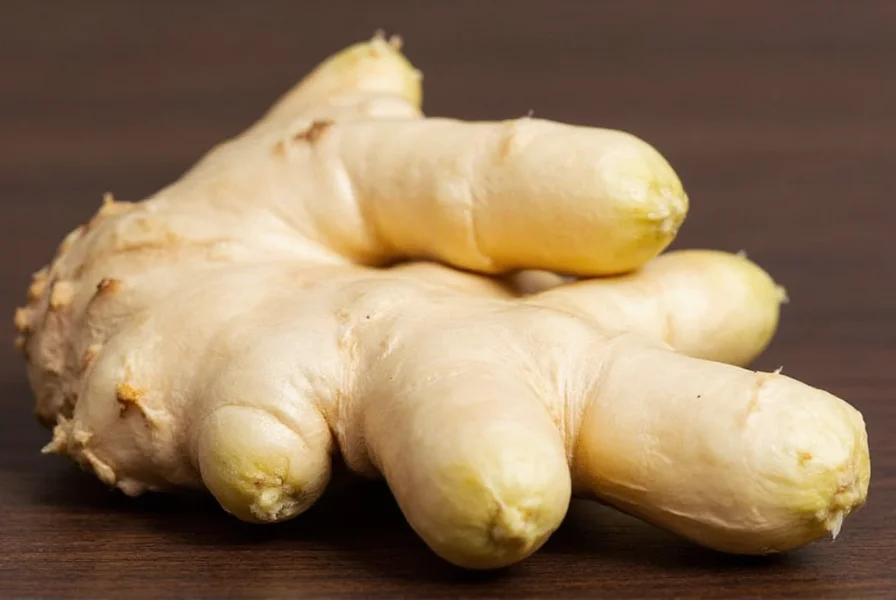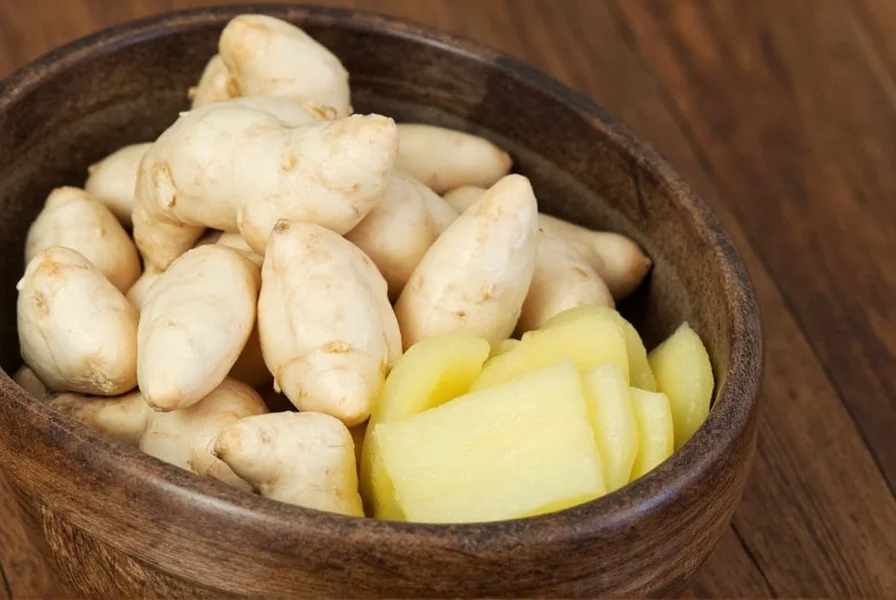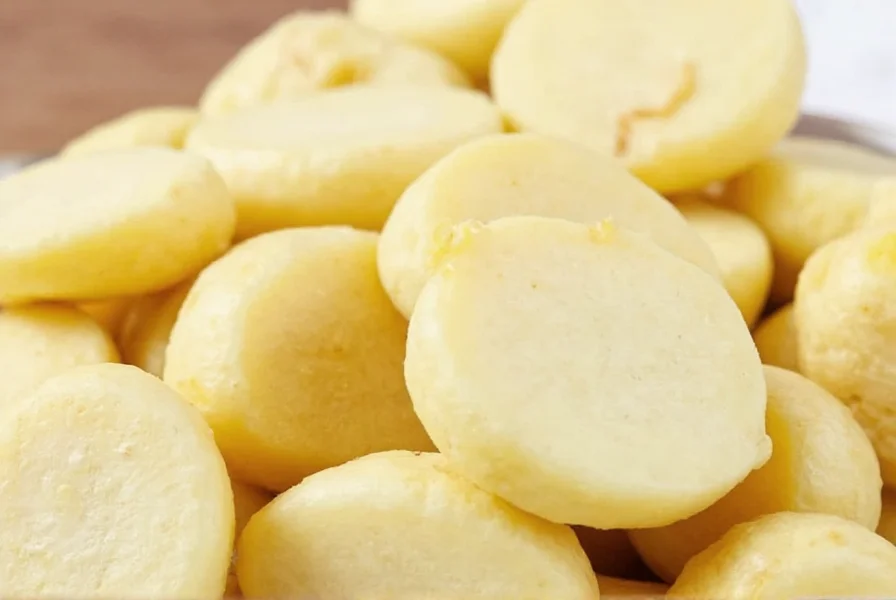Understanding the botanical and practical distinctions between white ginger and its more common cousin is essential for culinary enthusiasts and those exploring traditional botanical remedies. This comprehensive guide examines the characteristics, uses, and scientific insights about this often-misunderstood plant.
Botanical Identity and Physical Characteristics
White ginger (Zingiber zerumbet) belongs to the same family as common ginger but represents a separate species with distinctive features. The plant grows up to 1.5 meters tall with lush green leaves and produces unique inflorescences that resemble pinecones—earning it the alternative name "shampoo ginger" or "pinecone ginger."
The rhizomes of white ginger appear paler than common ginger, with a smoother skin texture and less fibrous interior. When cut open, they reveal a translucent, almost jelly-like consistency compared to the firm, fibrous texture of regular ginger. This structural difference significantly impacts both culinary applications and extraction methods for traditional preparations.
| Characteristic | White Ginger (Zingiber zerumbet) | Common Ginger (Zingiber officinale) |
|---|---|---|
| Scientific Classification | Zingiber zerumbet | Zingiber officinale |
| Rhizome Color | Pale yellow to white | Yellowish-brown |
| Flavor Profile | Milder, citrusy, less pungent | Sharp, spicy, pungent |
| Primary Bioactive Compound | Zerumbone | Gingerol |
| Traditional Regions | Southeast Asia, Pacific Islands | South Asia, globally cultivated |
Culinary Applications Across Cultures
Chefs specializing in Southeast Asian and Pacific Island cuisines value white ginger for its subtle flavor that enhances dishes without overwhelming other ingredients. In Hawaiian cooking, the gel-like substance inside mature inflorescences serves as a natural shampoo and hair conditioner—hence the "shampoo ginger" moniker.
Unlike common ginger which requires peeling, white ginger's smoother skin often allows direct use in preparations. Traditional applications include:
- Adding young rhizomes to seafood dishes in Thai cuisine for delicate flavor
- Using the floral cones in Hawaiian poi preparation
- Creating traditional relishes in Indonesian cooking
- Infusing beverages with milder ginger flavor for sensitive palates
When substituting white ginger for common ginger in recipes, cooks should note the flavor intensity difference. Culinary experts recommend using approximately 1.5 times the amount of white ginger to achieve similar flavor impact as regular ginger, making it particularly valuable for mild ginger flavor recipes for children or those with sensitive digestive systems.

Traditional Medicinal Uses and Scientific Research
Traditional medicine systems across the Pacific Islands have employed white ginger for centuries to address digestive discomfort, skin conditions, and inflammatory responses. Unlike common ginger which contains gingerol as its primary bioactive compound, white ginger's zerumbone has attracted scientific interest for its potential anti-inflammatory and antioxidant properties.
Current research on white ginger health benefits compared to regular ginger shows promising but preliminary results. A 2022 review in the Journal of Ethnopharmacology noted that zerumbone demonstrates stronger anti-inflammatory effects in laboratory settings than gingerol, though human clinical trials remain limited. Researchers emphasize that traditional uses shouldn't be conflated with medically proven treatments.
Those exploring natural remedies using white ginger should understand that most traditional applications lack robust clinical validation. The plant shows potential as a complementary approach, but shouldn't replace conventional medical treatments for serious conditions. Always consult healthcare providers before using botanicals for therapeutic purposes.
Cultivation and Sourcing Considerations
Gardeners interested in growing white ginger should note its preference for tropical climates with high humidity and partial shade. Unlike common ginger which tolerates slightly cooler temperatures, white ginger requires consistent warmth and cannot survive frost. The plant propagates through rhizome division and typically reaches maturity in 8-10 months under optimal conditions.
For those seeking where to buy authentic white ginger rhizomes, specialty Asian markets, tropical plant nurseries, and select online botanical suppliers represent the most reliable sources. When selecting rhizomes, look for firm, plump specimens without mold or excessive dryness. Fresh white ginger maintains quality for 2-3 weeks when stored in a cool, dark place—slightly longer than common ginger due to its higher moisture content.

Practical Usage Tips for Home Cooks
When incorporating white ginger into recipes, consider these evidence-based preparation techniques:
- Grate or finely mince young rhizomes for maximum flavor release in dressings and marinades
- Add white ginger early in cooking processes for soups and stews to allow flavor development
- Use the floral cones to create natural hair treatments by squeezing the gel-like interior
- Freeze excess rhizomes in airtight containers for up to six months without significant quality loss
Chef Mei Ling Chen, a specialist in Southeast Asian cuisine, notes: "White ginger's versatility shines in dishes where you want ginger flavor without the sharp heat. It's particularly effective in seafood preparations and delicate desserts where common ginger would dominate." This perspective aligns with culinary research showing white ginger's lower pungency makes it suitable for mild ginger applications in sensitive recipes.
Conclusion: Understanding White Ginger's Unique Value
White ginger represents a distinctive botanical with valuable culinary and traditional applications separate from common ginger. Its milder flavor profile, unique physical characteristics, and different bioactive compounds make it worthy of recognition as a separate ingredient rather than merely a variant of regular ginger.
As interest in diverse culinary ingredients grows, understanding the specific properties of white ginger allows cooks, gardeners, and wellness enthusiasts to make informed decisions about its appropriate uses. Whether exploring traditional Pacific Island recipes or seeking milder ginger alternatives, recognizing white ginger's unique characteristics enhances both culinary experiences and informed botanical appreciation.
What is the difference between white ginger and regular ginger?
White ginger (Zingiber zerumbet) differs from regular ginger (Zingiber officinale) in several key ways. White ginger has paler, smoother rhizomes with a milder, more citrusy flavor profile compared to the sharper, spicier taste of common ginger. The plants produce distinctive pinecone-shaped inflorescences, and white ginger contains zerumbone as its primary bioactive compound rather than gingerol found in regular ginger. These differences affect both culinary applications and potential health properties.
Can white ginger be used as a substitute for regular ginger in recipes?
White ginger can substitute for regular ginger in many recipes, but with important considerations. Due to its milder flavor, you'll typically need to use about 1.5 times the amount of white ginger to achieve similar flavor intensity. It works particularly well in dishes where a less pungent ginger flavor is desired, such as seafood preparations, delicate sauces, or recipes for sensitive palates. However, it won't provide the same sharp heat that regular ginger contributes to certain dishes.
Does white ginger have the same health benefits as regular ginger?
White ginger contains different bioactive compounds than regular ginger, primarily zerumbone rather than gingerol, which means its potential health effects differ. Preliminary research suggests zerumbone may have strong anti-inflammatory properties, but most studies remain in laboratory or animal testing stages. Unlike regular ginger which has more extensive research supporting certain digestive benefits, white ginger's traditional medicinal uses haven't been as thoroughly validated by clinical research. Always consult healthcare professionals before using any botanical for therapeutic purposes.
Where can I find white ginger for purchase?
Authentic white ginger rhizomes are typically available at specialty Asian markets, particularly those focusing on Southeast Asian or Pacific Island products. Tropical plant nurseries and select online botanical suppliers also carry live rhizomes for cultivation. When purchasing, look for firm, plump specimens without mold or excessive dryness. Some farmers' markets in warm climate regions may also carry white ginger during its growing season.
How do I grow white ginger successfully?
White ginger requires tropical conditions to thrive, needing consistent warmth (minimum 60°F/15°C), high humidity, and partial shade. Plant rhizome sections in well-draining, nutrient-rich soil with the growth buds facing upward, about 2 inches deep. Water regularly to maintain moist (not soggy) soil. The plant typically matures in 8-10 months. Unlike common ginger, white ginger cannot tolerate frost and requires protection from direct afternoon sun in hotter climates. It propagates through rhizome division rather than seeds.











 浙公网安备
33010002000092号
浙公网安备
33010002000092号 浙B2-20120091-4
浙B2-20120091-4